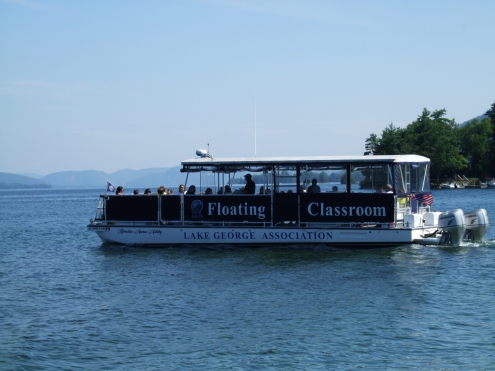
The LGA’s Floating Classroom as seen off of Huletts Landing in 2011.
The Lake George Association is pleased to announce that it has received $10,000 from the Helen and Ritter Shumway Foundation. The foundation was created from the estate of the late Helen Shumway to support conservation efforts. Facilitated by Jack Murphy at Bank of America, a manager of the Foundation, the funding will help support the LGA’s Floating Classroom program as well as Asian Clam management efforts.
The Floating Classroom is central to the mission of the Lake George Association, and a core element of its educational program. The program was originally conceived in 1990 as a means to provide a stirring, enlightening experience to area school children and to help them develop a stewardship interest in the Lake George ecosystem. The program has since grown and today has even expanded to include family groups and tourists in the summer season. The LGA’s Floating Classroom provides a unique hands-on experience for participants to learn about Lake George and how they can help protect it for the future. 2,228 people took part in the Floating Classroom program in 2013, over half of which were students on field trips in the spring and fall.
“We are so happy that we are able to offer the program for groups in the summer in addition to our usual school field trips. This new funding from the Shumway Foundation will help us be able to continue those programs,” said LGA’s Education Coordinator Kristen Rohne. “Everyone who goes out on the boat tells us how amazed they are with what they learn. For many people, this is the first and only time they will get to catch plankton and look at them under a microscope or use a secchi disk to measure water clarity,” said Rohne.
Asian clams were first found in Lake George in the fall of 2010 off Lake Avenue Beach in Lake George Village. Management efforts to kill the clams began right away in the spring of 2011, however unfortunately it has since spread to additional locations around the Lake. As of the most recent lake-wide survey completed this past September the clams have been found in 13 locations around the Lake. “The LGA and many partners have been working hard to keep this highly invasive species under control but its amazing reproductive capabilities seem to be keeping the clams one step ahead,” said LGA’s Executive Director Walt Lender. “We are continuing to work to better understand how the clams reproduce and spread, and then hope to use this information to better inform our future management efforts. Our experience with Asian clam illustrates how important education and prevention really are and why programs like the LGA’s Floating Classroom and Lake Stewards are so critical. We are very grateful to the Shumway Foundation for supporting these important programs.”
